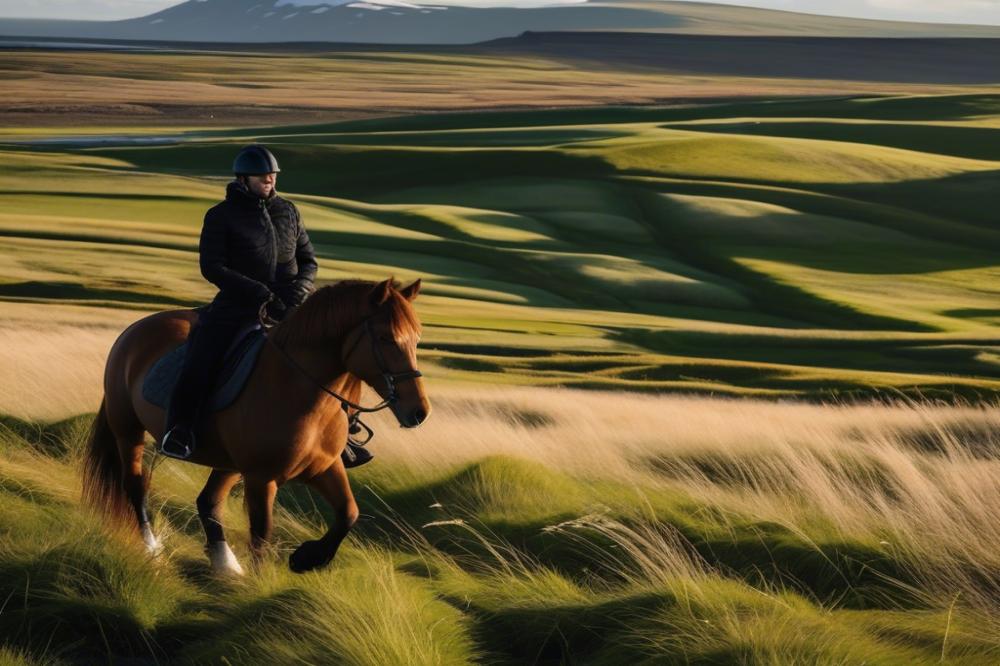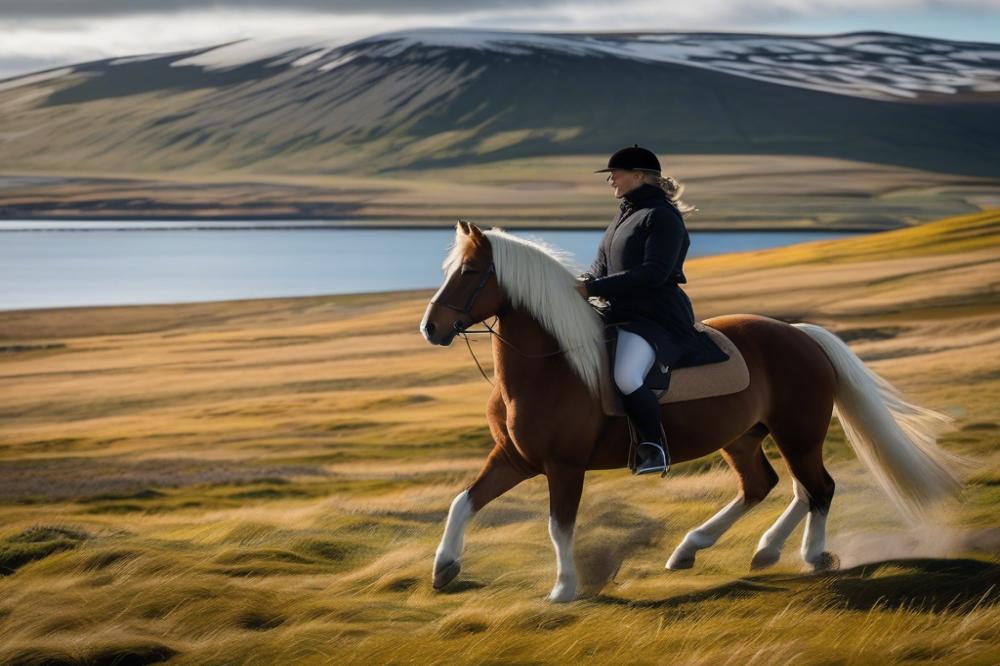How to Stay Balanced While Riding an Icelandic Horse’s Tölt
Tölt is a distinctive gait found in Icelandic horses, celebrated for its smoothness and versatility. Riders appreciate this special movement because it allows them to traverse various terrains comfortably. Unlike traditional trotting, the tölt provides a four-beat rhythm that feels both unique and soothing. Understanding this gait is essential for anyone interested in Icelandic horse riding.
riding balance plays a crucial role when experiencing the tölt. Without proper balance, riders may find the experience uncomfortable or even jarring. Maintaining a centered position helps in absorbing the horse’s movements while fostering a harmonious connection between rider and mount. This balance can transform an ordinary ride into a pleasurable journey.
This article will cover essential tips and techniques for maintaining balance during tölt. First, we will explore body positioning and how this can impact your experience. Next, key exercises will be discussed to improve your overall stability. Lastly, we’ll examine how to recognize and adjust for common mistakes beginners make. By the end, readers will feel more prepared to enjoy the joys of riding in tölt with confidence.
Understanding Icelandic horse tölt

Tölt is a special gait that sets Icelandic horses apart from other equine breeds. It can be described as a four-beat lateral gait, where each hoof hits the ground separately. This smooth movement allows riders to enjoy a comfortable experience, almost like gliding across the terrain. Unlike trot or gallop, tölt provides a steadiness that is easier on the rider’s body.
The primary distinction between tölt and other gaits lies in its rhythm. While the trot has a two-beat motion that can be jarring, tölt maintains a steady flow. Galloping, on the other hand, is faster and can feel less secure. The tölting horse can lift its neck and flaunt its head, showcasing both beauty and style. Riders do not have to navigate bumpy transitions, thanks to this gait’s smoothness.
Icelandic horses are not just skilled in tölt; they were bred for it. Their unique body structure, with a sturdy build and strong legs, supports this extraordinary movement. These horses have become crucial for Icelandic culture, often seen participating in traditional events and local competitions. The relationship between horse and rider grows deeper through shared experiences in tölt.
Mastering this gait does not happen overnight. Proper horsemanship plays a vital role in developing this skill. Riders must learn to communicate effectively with their horses, creating balance and trust. Good posture greatly affects performance. By maintaining the right position, riders enhance their ability to stay aligned with the horse’s movement. This practice fosters better control and a more enjoyable ride.
The Importance of Balance in riding techniques

Balance plays a crucial role in the overall riding experience. When a rider maintains good balance, communication with the horse improves. This connection forms a foundation based on trust and understanding. A well-balanced rider can respond better to their horse’s movements. This responsiveness enhances the ride significantly.
Posture directly influences balance while riding. Sitting up straight helps distribute weight evenly. Keeping the shoulders relaxed and the head up allows for better coordination. Riders should avoid leaning too far forward or backward. Correct posture not only feels better but also contributes to stability.
Several basic principles of equestrian skills revolve around balance. Engaging the core muscles is essential. This engagement provides strength for holding position. Control is easier to achieve when a rider utilizes their body correctly. Weight distribution affects how a horse reacts. Adjusting where weight is placed can signal various cues to the horse.
Foot placement also plays a key role in maintaining balance. Placing heels down helps lower the center of gravity. This positioning makes it easier to stay centered. Additionally, a rider should be mindful of their legs. Keeping them soft and close to the horse ensures a more secure seat.
Breathing is another aspect often overlooked. Calm, steady breaths help maintain focus. A tense rider may disrupt the horse’s rhythm. Staying relaxed protects against losing balance during the ride. As tension grows, even experienced riders may struggle to maintain their seat.
Lastly, practice is vital. Skills develop over time, and riders should be patient with themselves. Taking time to feel the horse’s movements can enhance balance. Each ride provides an opportunity for growth. With consistent effort, balance can become second nature.
Mastering Rider Posture and Saddle Position

Riding an Icelandic horse’s tölt requires correct posture for balance and comfort. First, your head should remain up. Look forward, not down. Keeping your shoulders relaxed but aligned over your hips helps in maintaining a good position. A straight back is also essential. You want to feel sturdy yet flexible in your seat. Elbows should be slightly bent, allowing a natural position for your hands and reins.
Correct saddle position plays a crucial role in your overall balance. When you sit in the saddle, ensure it is positioned so that your weight is distributed evenly. The saddle should not be too far forward or back. Adjust it so that your legs hang comfortably with a slight bend in your knee. It should feel secure; an unstable saddle can lead to a loss of balance.
Incorrect saddle placement affects rider stability significantly. If the saddle is too far forward, it can push you onto your horse’s neck. This position makes it difficult to maintain balance and staying upright. On the flip side, a saddle placed too far back can create a tendency to tip backward. Both scenarios can lead to discomfort and can make riding for extended periods difficult.
To maintain a balanced posture while riding, focus on your core. Engaging your abdominal muscles helps shift your weight and creates more control. Please remember to breathe evenly; tension can lead to rigidity in your posture. Adjusting your stirrups may also aid comfort. A slightly longer stirrup can allow for a more natural leg position, enhancing your stability.
Lastly, practice makes perfect. Spend time figuring out what works best for your body. Encourage a sense of connection with your horse while in motion. This will naturally improve your balance and skill in riding. Keep experimenting and find the posture that feels right for you.
Balance Exercises for Tölt Training
Riding an Icelandic horse’s tölting can be a thrilling experience, but it requires good balance and coordination. Learning specific exercises can help riders improve their stability. Incorporating these activities into your routine will retain your interest while enhancing your skills.
Ground Exercises for Stability
Start with ground exercises that target your core strength and stability. One effective drill is the single-leg balance. Stand on one leg while bending the knee of your other leg, and hold that position for 30 seconds. This practice builds essential muscles used when perched in the saddle.
The balance board is another excellent tool. By standing on it, you can simulate the shifting movements you experience while riding. Try finding your center and maintain your balance as the board wobbles beneath you.
Yoga can also play a significant role. Focus on poses like the tree pose or warrior pose to develop awareness of your body in space. Each pose requires concentration and engages the core, which will all aid in your riding endeavors.
Core Muscle Strengthening
Core muscles are vital for maintaining balance while riding. Strong abdominal and lower back muscles keep you centered in the saddle. Planks are a simple yet effective way to strengthen these areas. Start with a basic forearm plank and hold it for as long as you can.
Incorporating leg raises can also help. Lie flat on your back, lift your legs to a 90-degree angle, then slowly lower them without touching the ground. This targets your lower abdomen and supports riding balance.
Balance Drills On and Off the Horse
Practice balance drills both on the ground and in the saddle. While riding, try to ride without stirrups for short periods of time. This will challenge your balance and force you to engage your core. Focus on staying relaxed yet centered.
Another effective drill is the side-to-side weight shift. While riding, gently shift your weight from one side of the horse to the other. This mimics the movement of the tölting and helps prepare you for the horse’s natural gait.
Off the horse, you can challenge your balance by trying exercises on a Bosu ball. Stand on it while performing arm movements or squats. This creates an unstable surface that will enhance your coordination.
Maintaining balance is critical for enjoying the ride. With consistent practice of these exercises, your stability and coordination will improve. Tölt training can become even more rewarding when you add dedicated balance work.
Engaging with Your Horse for Better Balance
Effective communication with your horse plays a vital role in achieving balance. Horses are sensitive animals that pick up on the slightest cues from their riders. Connecting with your mount through clear signals allows for a smoother ride, especially during tölt.
Body language is essential in the training process. Your posture and movements should mirror what you want your horse to do. If your shoulders are relaxed, your horse can better understand your direction. Leaning forward or backward can confuse them, disrupting the rhythm of tölt.
Building a responsive connection takes practice. Start by developing trust with your horse. Spend time grooming or simply standing near them. This interaction fosters a bond, making your horse more attuned to your needs while riding.
Maintain a soft seat in the saddle. Avoid gripping with your legs tightly. Instead, use your legs gently to encourage forward motion. A calm rider often leads to a calmer horse. This balance can enhance your overall riding experience.
Try to keep your mind focused on the flow. Being present helps you respond quickly to your horse’s movements. Notice how they react to subtle shifts in your weight. Such awareness allows you to adjust and stay balanced during the tölt.
Practice your breathing. Inhale deeply and exhale slowly to relax both yourself and your horse. Tension in your body can affect their performance. A calm rider creates a more harmonious experience.
Use your core muscles to keep steady in the saddle. Engaging your core offers stability without compromising your relaxed posture. This connection between your body and the horse creates a seamless interaction, improving balance for both of you.
Lastly, don’t forget to celebrate small victories. Every successful ride boosts your confidence. This, in turn, strengthens the bond with your horse. A positive mindset contributes significantly to balance and overall enjoyment.
Safe Riding Practices for Equestrian Safety
Safety gear is vital for every rider. A properly fitted helmet should be non-negotiable. It protects against head injuries, which can have serious consequences. Boots with a defined heel are also essential, as they prevent the foot from slipping through the stirrup. Additionally, wearing gloves enhances grip on the reins and protects your hands.
When practicing tölt, focus on maintaining a balanced posture. Keep your body relaxed yet engaged. Tensing up can throw off your balance and make riding uncomfortable. Position your feet correctly in the stirrups. Supporting your weight correctly allows better control and stability. Use your core muscles to help you stay centered. This technique can greatly improve your overall riding experience.
Choosing the right environment for training is crucial. An enclosed arena offers a safe space, minimizing distractions. Open fields can be exciting, but they may also pose risks if not monitored. Look for a location with good footing to prevent slips and falls. Avoid busy roads and areas where unexpected obstacles might appear. Familiarizing yourself with the training area will also boost confidence.
Final Thoughts on Balance in Tölt
Maintaining balance while riding is crucial, especially with the Icelandic horse tölt. Key points revolve around posture, body awareness, and connection with your horse. A strong seat is essential. Riders should keep their core engaged and sit deep in the saddle. This helps absorb the horse’s movements and enhances stability. Adjusting your center of gravity can make a noticeable difference.
Communication with your horse cannot be overlooked. Trust and understanding develop through proper cues and gentle leg pressure. As you work together, the bond strengthens. Good horsemanship is founded upon this relationship. It is as much about the rider’s confidence as it is about the horse’s willingness.
Practice remains fundamental. Regularly ride in different settings to encounter various challenges. This not only hones your balance but also enhances your overall equestrian skills. Each ride provides an opportunity to learn and grow. Even experienced riders find room for improvement.
Safety should always be a priority. Wear the appropriate gear and be aware of your surroundings. Falls can happen, but they can be mitigated with preparation and awareness. Riders should never hesitate to seek guidance from experienced trainers.
In summary, a dedicated approach to balance, combined with effective communication and a focus on safety, sets the stage for an enjoyable riding experience. Riders are encouraged to keep exploring and developing their skills. Balance training is a journey worth undertaking. Every effort leads to greater confidence both in and out of the saddle.



